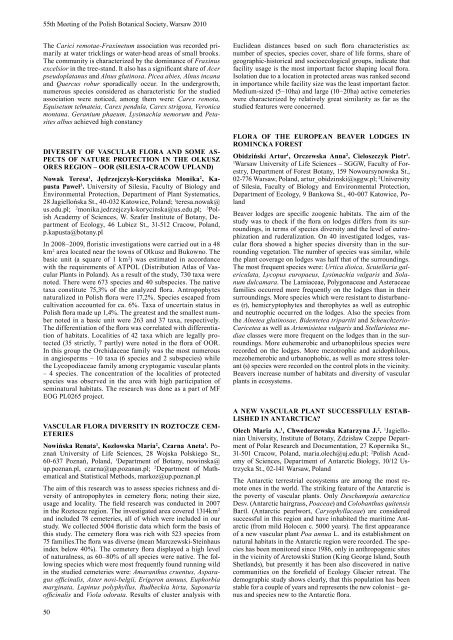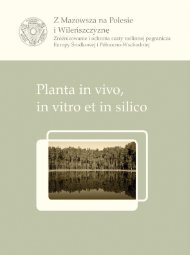acta societatis botanicorum poloniae - LV Zjazd Polskiego ...
acta societatis botanicorum poloniae - LV Zjazd Polskiego ...
acta societatis botanicorum poloniae - LV Zjazd Polskiego ...
You also want an ePaper? Increase the reach of your titles
YUMPU automatically turns print PDFs into web optimized ePapers that Google loves.
55th Meeting of the Polish Botanical Society, Warsaw 2010<br />
The Carici remotae-Fraxinetum association was recorded primarily<br />
at water tricklings or water-head areas of small brooks.<br />
The community is characterized by the dominance of Fraxinus<br />
excelsior in the tree-stand. It also has a significant share of Acer<br />
pseudoplatanus and Alnus glutinosa. Picea abies, Alnus incana<br />
and Quercus robur sporadically occur. In the undergrowth,<br />
numerous species considered as characteristic for the studied<br />
association were noticed, among them were: Carex remota,<br />
Equisetum telmateia, Carex pendula, Carex strigosa, Veronica<br />
montana. Geranium phaeum, Lysimachia nemorum and Petasites<br />
albus achieved high constancy<br />
dIVErSITY OF VASCULAr FLOrA ANd SOME AS-<br />
PECTS OF NATUrE PrOTECTION IN THE OLKUSZ<br />
OrES rEGION – OOr (SILESIA-CrACOW UPLANd)<br />
Nowak Teresa 1 , Jędrzejczyk-Korycińska Monika2 , Kapusta<br />
Paweł3 . University of Silesia, Faculty of Biology and<br />
Environmental Protection, Department of Plant Systematics,<br />
28 Jagiellońska St., 40-032 Katowice, Poland; 1teresa.nowak@ us.edu.pl; 2monika.jedrzejczyk-korycinska@us.edu.pl; 3Pol ish Academy of Sciences, W. Szafer Institute of Botany, Department<br />
of Ecology, 46 Lubicz St., 31-512 Cracow, Poland,<br />
p.kapusta@botany.pl<br />
In 2008– 2009, floristic investigations were carried out in a 48<br />
km2 area located near the towns of Olkusz and Bukowno. The<br />
basic unit (a square of 1 km2 ) was estimated in accordance<br />
with the requirements of ATPOL (Distribution Atlas of Vascular<br />
Plants in Poland). As a result of the study, 730 taxa were<br />
noted. There were 673 species and 40 subspecies. The native<br />
taxa constitute 75,3% of the analyzed flora. Antropophytes<br />
naturalized in Polish flora were 17,2%. Species escaped from<br />
cultivation accounted for ca. 6%. Taxa of uncertain status in<br />
Polish flora made up 1,4%. The greatest and the smallest number<br />
noted in a basic unit were 263 and 37 taxa, respectively.<br />
The differentiation of the flora was correlated with differentiation<br />
of habitats. Localities of 42 taxa which are legally protected<br />
(35 strictly, 7 partly) were noted in the flora of OOR.<br />
In this group the Orchidaceae family was the most numerous<br />
in angiosperms – 10 taxa (6 species and 2 subspecies) while<br />
the Lycopodiaceae family among cryptogamic vascular plants<br />
– 4 species. The concentration of the localities of protected<br />
species was observed in the area with high participation of<br />
seminatural habitats. The research was done as a part of MF<br />
EOG PL0265 project.<br />
VASCULAr FLOrA dIVErSITY IN rOZTOCZE CEM-<br />
ETErIES<br />
Nowińska Renata1 , Kozłowska Maria2 , Czarna Aneta1 . Poznań<br />
University of Life Sciences, 28 Wojska <strong>Polskiego</strong> St.,<br />
60-637 Poznań, Poland, 1Department of Botany, nowinska@<br />
up.poznan.pl, czarna@up.pozanan.pl; 2Department of Mathematical<br />
and Statistical Methods, markoz@up.poznan.pl<br />
The aim of this research was to assess species richness and diversity<br />
of antropophytes in cemetery flora; noting their size,<br />
usage and locality. The field research was conducted in 2007<br />
in the Roztocze region. The investigated area covered 1314km 2<br />
and included 78 cemeteries, all of which were included in our<br />
study. We collected 5004 floristic data which form the basis of<br />
this study. The cemetery flora was rich with 523 species from<br />
75 families.The flora was diverse (mean Marczewski-Steinhaus<br />
index below 40%). The cemetery flora displayed a high level<br />
of naturalness, as 60– 80% of all species were native. The following<br />
species which were most frequently found running wild<br />
in the studied cemeteries were: Amaranthus cruentus, Asparagus<br />
officinalis, Aster novi-belgii, Erigeron annuus, Euphorbia<br />
marginata, Lupinus polyphyllus, Rudbeckia hirta, Saponaria<br />
officinalis and Viola odorata. Results of cluster analysis with<br />
50<br />
Euclidean distances based on such flora characteristics as:<br />
number of species, species cover, share of life forms, share of<br />
geographic-historical and socioecological groups, indicate that<br />
facility usage is the most important factor shaping local flora.<br />
Isolation due to a location in protected areas was ranked second<br />
in importance while facility size was the least important factor.<br />
Medium-sized (5– 10ha) and large (10– 20ha) active cemeteries<br />
were characterized by relatively great similarity as far as the<br />
studied features were concerned.<br />
FLOrA OF THE EUrOPEAN BEAVEr LOdGES IN<br />
rOMINCKA FOrEST<br />
obidziński Artur1 , Orczewska Anna2 , Cieloszczyk Piotr1 .<br />
1Warsaw University of Life Sciences – SGGW, Faculty of Forestry,<br />
Department of Forest Botany, 159 Nowoursynowska St.,<br />
02-776 Warsaw, Poland, artur_obidzinski@sggw.pl; 2University of Silesia, Faculty of Biology and Environmental Protection,<br />
Department of Ecology, 9 Bankowa St., 40-007 Katowice, Poland<br />
Beaver lodges are specific zoogenic habitats. The aim of the<br />
study was to check if the flora on lodges differs from its surroundings,<br />
in terms of species diversity and the level of eutrophization<br />
and ruderalization. On 40 investigated lodges, vascular<br />
flora showed a higher species diversity than in the surrounding<br />
vegetation. The number of species was similar, while<br />
the plant coverage on lodges was half that of the surroundings.<br />
The most frequent species were: Urtica dioica, Scutellaria galericulata,<br />
Lycopus europaeus, Lysimachia vulgaris and Solanum<br />
dulcamara. The Lamiaceae, Polygonaceae and Asteraceae<br />
families occurred more frequently on the lodges than in their<br />
surroundings. More species which were resistant to disturbances<br />
(r), hemicryptophytes and therophytes as well as eutrophic<br />
and neutrophic occurred on the lodges. Also the species from<br />
the Alnetea glutinosae, Bidentetea tripartiti and Scheuchzerio-<br />
Caricetea as well as Artemisietea vulgaris and Stellarietea mediae<br />
classes were more frequent on the lodges than in the surroundings.<br />
More euhemerobic and urbanophilous species were<br />
recorded on the lodges. More mezotrophic and acidophilous,<br />
mezohemerobic and urbanophobic, as well as more stress tolerant<br />
(s) species were recorded on the control plots in the vicinity.<br />
Beavers increase number of habitats and diversity of vascular<br />
plants in ecosystems.<br />
A NEW VASCULAr PLANT SUCCESSFULLY ESTAB-<br />
LISHEd IN ANTArCTICA?<br />
Olech Maria A. 1 , Chwedorzewska Katarzyna J. 2 . 1 Jagiellonian<br />
University, Institute of Botany, Zdzisław Czeppe Department<br />
of Polar Research and Documentation, 27 Kopernika St.,<br />
31-501 Cracow, Poland, maria.olech@uj.edu.pl; 2 Polish Academy<br />
of Sciences, Department of Antarctic Biology, 10/12 Ustrzycka<br />
St., 02-141 Warsaw, Poland<br />
The Antarctic terrestrial ecosystems are among the most remote<br />
ones in the world. The striking feature of the Antarctic is<br />
the poverty of vascular plants. Only Deschampsia antarctica<br />
Desv. (Antarctic hairgrass, Poaceae) and Colobanthus quitensis<br />
Bartl. (Antarctic pearlwort, Caryophyllaceae) are considered<br />
successful in this region and have inhabited the maritime Antarctic<br />
(from mild Holocen c. 5000 years). The first appearance<br />
of a new vascular plant Poa annua L. and its establishment on<br />
natural habitats in the Antarctic region were recorded. The species<br />
has been monitored since 1986, only in anthropogenic sites<br />
in the vicinity of Arctowski Station (King George Island, South<br />
Shetlands), but presently it has been also discovered in native<br />
communities on the forefield of Ecology Glacier retreat. The<br />
demographic study shows clearly, that this population has been<br />
stable for a couple of years and represents the new colonist – genus<br />
and species new to the Antarctic flora.



